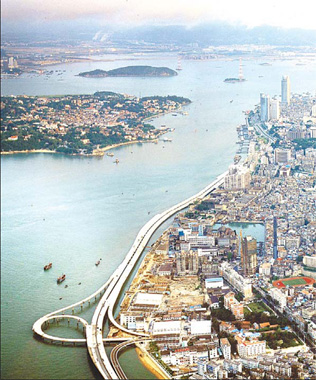'Egret Island' retains green roots
|
Xiamen, a burgeoning coastal city that values preservation of its environmental inheritance. |
Xiamen island, the fourth largest island of Fujian province, covers an area of 128.14 sq km. It is also known as the "Egret Island", a legacy of its long association with one of China's most abiding myths.
The tale tells of a time long ago when Xiamen was a remote and lifeless island. One day, a flock of egrets arrived and immediately made their homes on the island, charmed by its abundance of fish and shrimps and its lack of predators.
The egrets started to decorate their new home by digging springs with their beak and talons. Some fetched flower and tree seeds and planted them on the island. Soon bees, butterflies and many other kinds of birds were attracted to this beautiful island where the flowers and trees grew so freely.
As time went by, the island became ever more colorful and lively and thus Xiamen took the name egret island in memory of the birds that had contributed so much to it. Today, Xiamen is a prosperous metropolis with high-rising skyscrapers and fast-flowing traffic. The city, however, has also preserved its commitment to environmental protection.
The island's forest coverage is still above 40 percent, twice that of the national average. Its industrial water-recycling rate is in excess of 90 percent, compared to 60 percent throughout the rest of the province. As for the egrets, well they can still be seen in the lakes, mountains and universities of the city.
The quality of Xiamen's environment has bee widely recognized. The city was honored as a State-level garden city and a model city for environmental protection by the central government in 1997. The city also received the China Habitat Award in 2003 and the Habitat Scroll of Honor Award from UN-Habitat one year later.
Despite its success, Xiamen's efforts to protect its environment continue. At the end of October, 900 families in the island's Xucuo community began to use natural gas for daily cooking.
By the end of this year, 240,000 pipeline gas users will have switched to natural gas, causing significantly less pollution than the use of liquefied petroleum gas.
Natural gas will also be adopted in the public transport sector in the city. From 2010 on, the city has plans to promote natural gas-driven buses as a way of reducing exhaust gas emission. In the first stage of the program, three natural gas stations will be built.
Xiamen plans to eliminate 510 outmoded buses with high emission rates during 2009 and has ordered 400 new ones to take their place. The city also plans to develop river buses when its watercourses are cleared in the future.
Xiamen is also considering the introduction of emission records for vehicles in the city and will issue certificates to those vehicles whose exhaust gas emissions are within certain limits.
Vehicles without certificates will not be allowed to enter central Xiamen after January 2010, according to the Xiamen Environmental Protection Bureau.
The bureau also said sewage from 60 percent of the 400 rural villages in Xiamen will be processed before being discharged after 2011.
As part of the process of environmental protection, many ordinary Xiamen people have also contributed hugely. Because of their 12-month opposition to the project, a paraxylene (PX) plant, involving a total investment of 10.8 billion yuan, the largest industrial project backed by the municipal government in 2006, has been scrapped.
Paraxylene is primarily used as a raw material in the manufacture of polyethylene terephthalate (PET) materials.
Although the plant could potentially have contributed 80 billion yuan of annual industrial output value to the city, Xiamen's citizens were concerned that the plant would be the source of serious air and water pollution, representing a real health risk in the area. Thousands of citizens subsequently took part in a protest walk against the project.
Xiamen is now shifting its focus to environmentally friendly industries, such as finance, software and tourism. The city now aims to raise the contribution of its financial sector to its GDP from the current eight percent to 10 percent within two years, according to Ding Guoyan, deputy mayor of the city.
According to a policy newly implemented by the municipal government, Xiamen will provide subsidies for renewable energy projects and companies that eliminate outdated equipment and technologies in order to reduce consumption and emission. This subsidy will be as much as two million yuan per project.
According to another policy, currently waiting endorsement by the municipal People's Congress, businesses in Xiamen guilty of marine pollution will be placed on a blacklist.
In addition to direct penalties of between 50,000 yuan and 200,000 yuan, these companies will be ineligible to undertake local government projects or apply for bank loans.
(China Daily 11/16/2009 page6)















